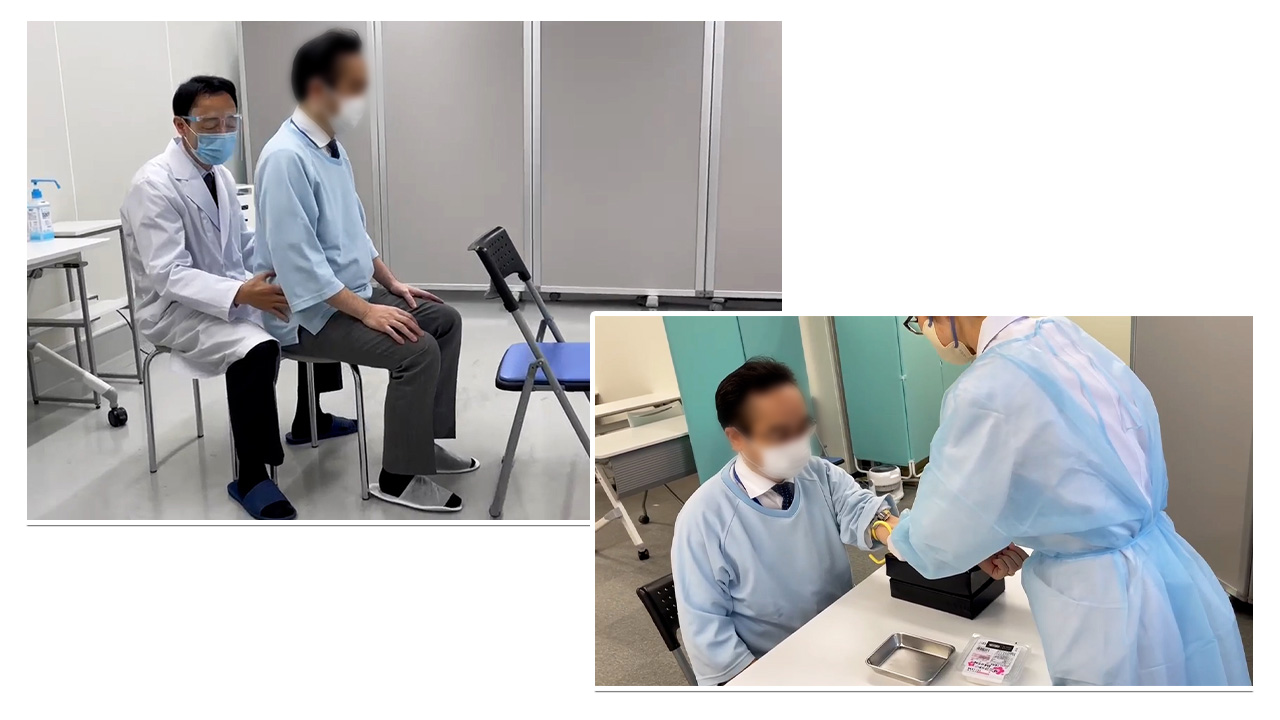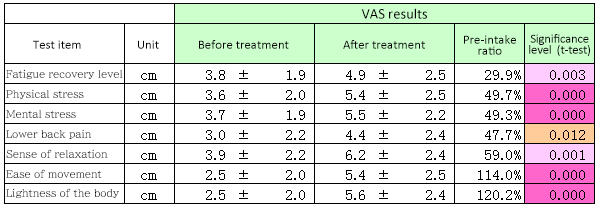Autonomic nervous system and "kanshoho"
Explanatory Video
Relationship between autonomic nervous system and “kanshoho”
In the biochemical study titled “Verification of the pain reduction effect of muscle relaxation treatment on the lower back (1),” published in 2012, it was found that the levels of serotonin in the blood significantly increased after the treatment. This suggests that the treatment led to a shift towards calming the mind and body, indicating a state of relaxation.
Furthermore, considering the slight but not significant decrease in LF/HF among heart rate variability parameters, it can be inferred that there was an interconnected change between neurotransmitters and the autonomic nervous system due to the treatment. The increase in blood calcium and serotonin levels following the treatment suggests the effectiveness of the therapy.
Furthermore, in a study published in 2012 titled “The effect of Kanshoho on the low back pain (lumbago) (2),” regarding heart rate variability, HF representing parasympathetic nervous system activity significantly decreased. However, LF, VLF, and TP, while not significant, also showed decreases, and LF/HF decreased as well. In the previous study (1), HF significantly decreased, and LF and LF/HF, while not significant, also decreased. Therefore, the findings obtained in this study regarding heart rate variability are considered robust.
Looking at the VAS (Visual Analog Scale) results for each item, there were significant differences in all categories, including fatigue recovery, stress reduction, feeling of lightness and ease of movement, relaxation, and reduction in lower back pain. This suggests that the treatment led to a calming effect on both the mind and body.
In the study titled “Comprehensive Analysis of Blood Metabolites Following Muscle Relaxation Therapy in 2022 (3) [UMIN Trial ID] UMIN000049180,” Acylcarnitine (13:1)-3 and Acylcarnitine (17:0)-2 showed a significant increase.
The Acylcarnitine that significantly increased in the treatment group compared to before the treatment in the study has been reported to alleviate pain induced by the anticancer drug paclitaxel (4). Although the mechanism is unknown, there is interest in its relationship with pain relief.
Additionally, in patients with chronic fatigue syndrome characterized by symptoms such as headache, muscle pain, and joint pain, a decrease in Acylcarnitine in the blood has been observed (5).
Furthermore, according to PET analysis using 11C-labeled Acylcarnitine, it is known that in patients with chronic fatigue syndrome, there is a decrease in the uptake of Acylcarnitine in the anterior cingulate cortex area 24, which is deeply related to the regulation of the autonomic nervous system and emotion, and in the prefrontal cortex area 9, which is deeply related to motivation and communication (6).
In addition to these findings, it is expected that the effects of this treatment on central nervous system functions can be anticipated, not only for pain relief but also for various other significant changes
(*Details of other significantly changed items are described in “Metabolites and Kanshoho“)

Therefore, based on the observations such as “a significant decrease in HF, which indicates activation of the parasympathetic nervous system,” and “a significant increase in Acylcarnitine (13:1)-3 and Acylcarnitine (17:0)-2,” it is believed that the treatment has a relaxing effect due to the alleviation of various nonspecific complaints.
We strongly encourage the integration of “kanshoho” into medical practice to help relieve pain and suffering in as many patients as possible. Let’s work together to save as many patients as we can from pain and illness.
(1) Shinichiro Yamashita et al., Verification of Pain Reduction Effect by Muscle Relaxation Technique (Kanshoho) Applied to the Lumbar Region, The 15th Japan Integrated Medicine Society, Abstracts, p118, 2012.
(2) Hirozumi sakaguchi, Takashi Sakato, Kazuo Yamamoto, Naoko Suzuki, Koji Shiizuka, Tsuyoshi Takara The effect of Kanshoho on the low back pain (lumbago) Japanese Journal of Integrative Medicine, 2012, 5(1),62-67.
(3) https://rctportal.niph.go.jp/s/detail/um?trial_id=UMIN000049180
(4) Flatters SJ, Xiao WH, Bennett GJ. Acetyl-L-carnitine prevents and reduces paclitaxel-induced painful peripheral neuropathy. Neurosci Lett. 2006 Apr 24;397(3):219-23.
(5) Kuratsune H, Yamaguti K, Takahashi M, Misaki H, Tagawa S, Kitani T. Acylcarnitine deficiency in chronic fatigue syndrome. Clin Infect Dis. 1994 Jan;18 Suppl 1:S62-7.
(6) Kuratsune H, Yamaguti K, Lindh G, Evengård B, Hagberg G, Matsumura K, Iwase M, Onoe H, Takahashi M, Machii T, Kanakura Y, Kitani T, Långström B, Watanabe Y. Brain regions involved in fatigue sensation: reduced acetylcarnitine uptake into the brain. Neuroimage. 2002 Nov;17(3):1256-65.





